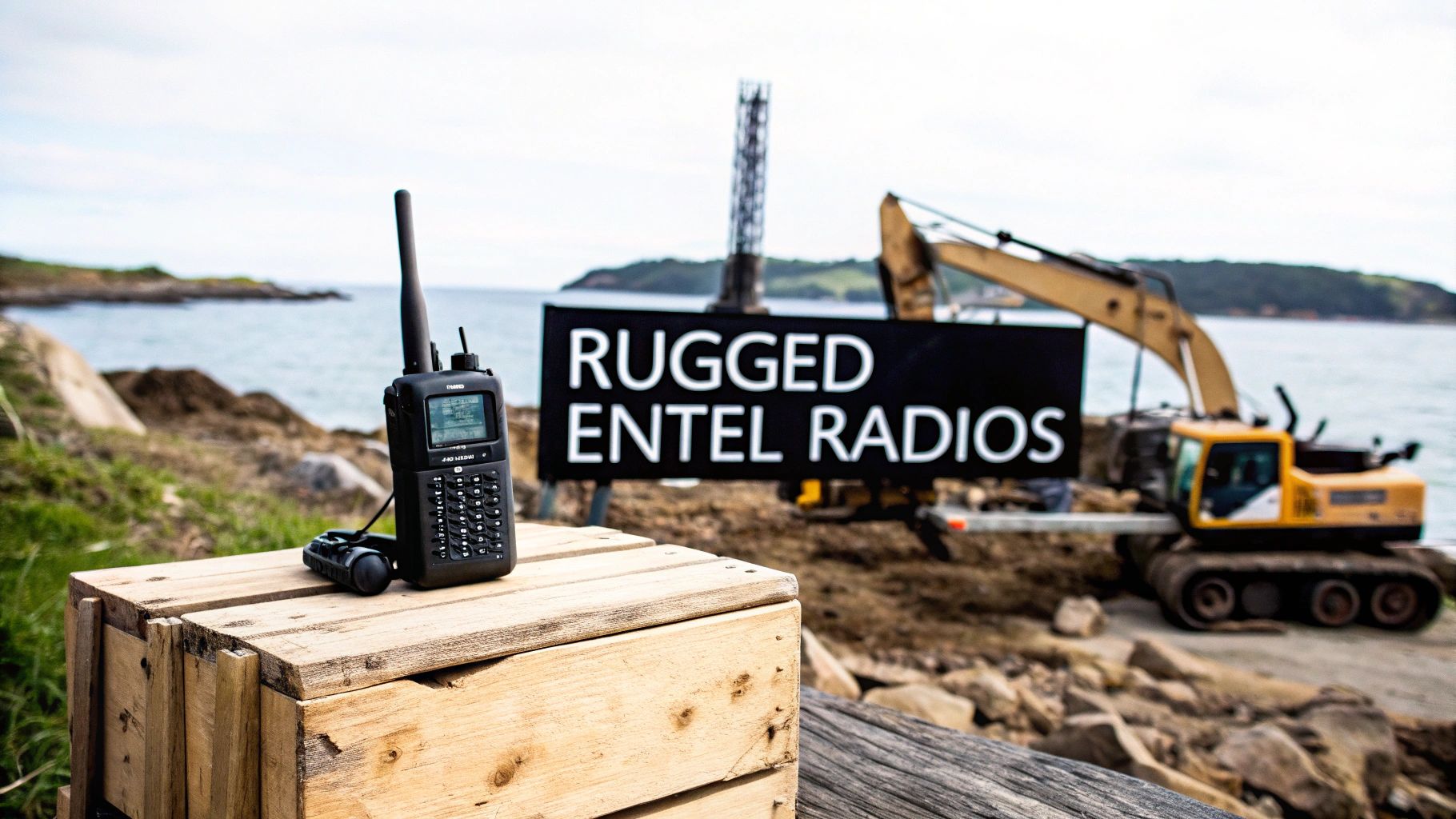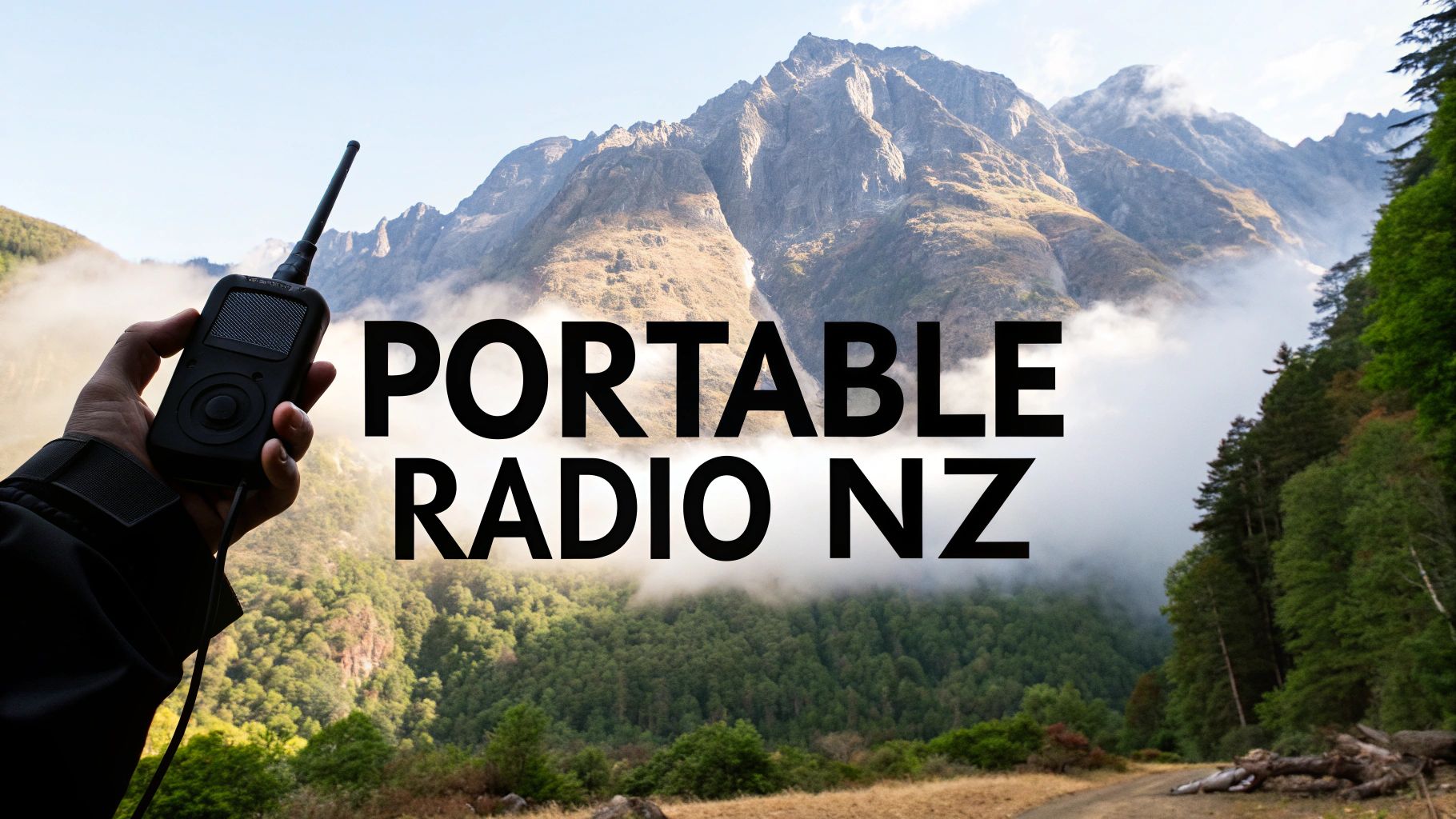CB Radio NZ: Complete Kiwi Guide To Citizens Band Radios
Understanding CB Radio NZ: Why We're Different From The World
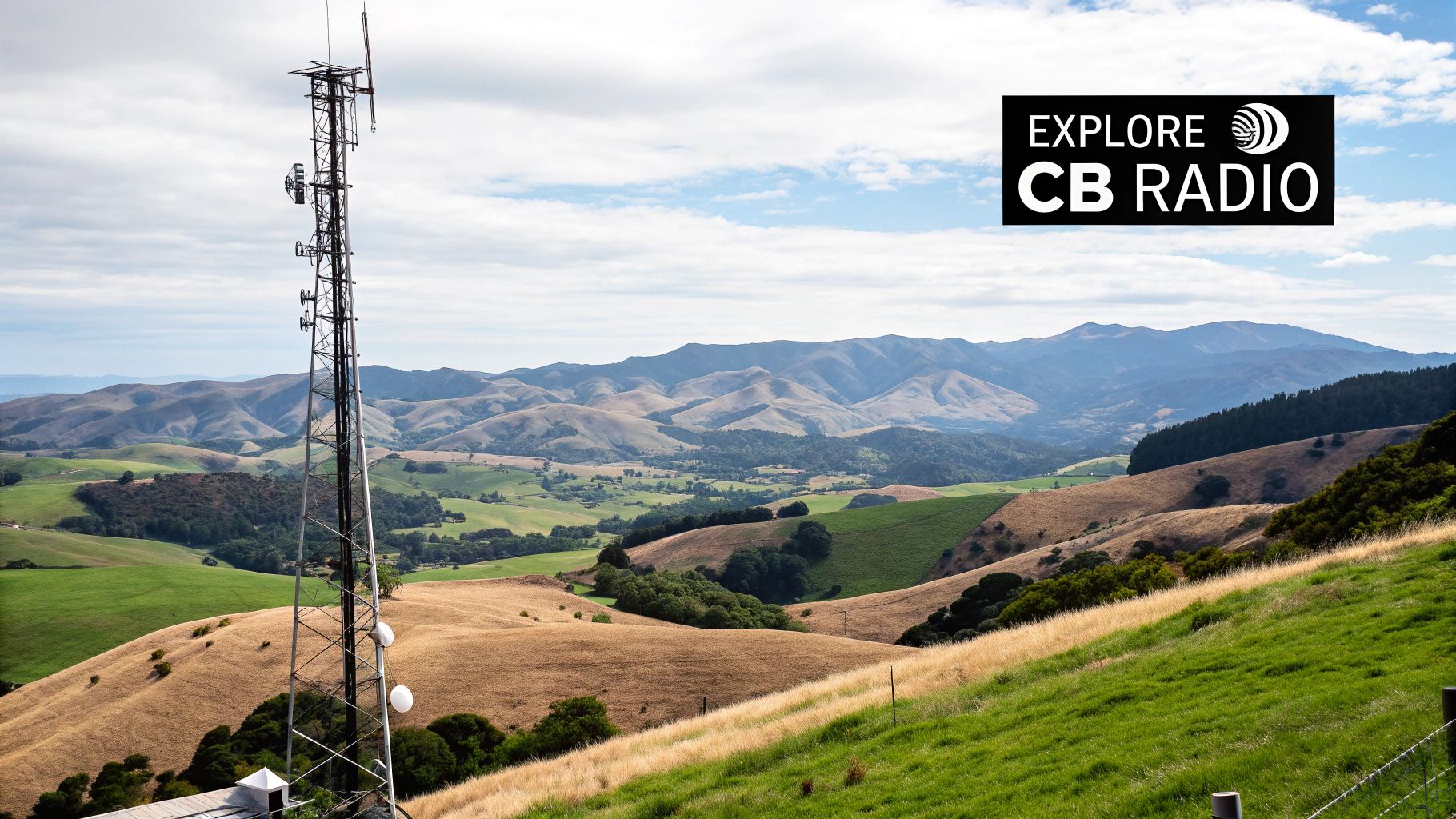
Here in New Zealand, our CB radio situation is unique. A standard CB radio bought online or in Australia might not work here. Why? New Zealand operates on the 26MHz frequency band, unlike the 27MHz standard used internationally. This seemingly small difference has a big impact on your CB radio experience.
This frequency variation is crucial when choosing equipment. A 27MHz CB radio is useless in New Zealand. Kiwis must confirm 26MHz compatibility before purchasing, or risk wasting their money.
The History Behind Our Unique Frequency
New Zealand's unique frequency stems from early regulations and technology choices. Until July 1994, individual licenses were required to operate a CB radio. Around 14,500 sets were licensed nationwide, each with a fee. Learn more about this history. Switching to a class license system made CB radios much more accessible, particularly for the transport industry, rural communities, and hobbyists.
Why 26MHz Matters: Practical Implications
The 26MHz frequency impacts several aspects of CB radio use, including communication range. It requires specialized 26MHz equipment. This is vital for industries like transport, where reliable communication is essential. AM CB radios are still the dominant choice in New Zealand's transport sector, thanks to their reliability and established use within the trucking community.
Crossing the Ditch: Challenges for Trans-Tasman Truckers
The frequency difference between New Zealand and Australia creates challenges for truckers crossing the Tasman. Imagine switching CB radios at the border – it's like needing two languages for the same conversation! Truckers need dual-frequency radios or must swap units, adding cost and complexity.
Understanding New Zealand's unique CB radio landscape is essential. It’s not just about regulations; it’s about ensuring effective communication in various situations, from nationwide logistics to staying connected in remote areas.
CB Radio NZ Licensing: What Every Kiwi Needs To Know
Getting a CB radio license in New Zealand is easier than you might think. The old annual license fees are a thing of the past, replaced by a class license system. This system makes CB radio accessible to everyone while still maintaining important safety and operational standards.
Understanding Type-Approval
Before we get into the specifics, it's important to understand type-approval. This simply means your radio equipment meets New Zealand's technical standards. It’s the first thing to check when buying a CB radio. Without type-approval, using your radio is illegal, no matter what other features it has. Think of it like a Warrant of Fitness for your car—it’s essential for legal operation.
Power Limits and Frequency Allocations
New Zealand law sets power limits for CB radios. This ensures fair usage and prevents one user from overpowering others. Sticking to these limits isn’t just about following the law; it’s also good CB radio etiquette. In addition to power limits, specific frequency allocations prevent interference. This organized system keeps channels clear and communication efficient.
Compliance and Enforcement
Operating a non-compliant CB radio can lead to fines. While the class license system eliminates individual fees, it doesn’t remove the responsibility of using approved equipment. Enforcement officers can check for compliance, so make sure your radio meets all the requirements. This will protect you from penalties and contribute to a well-functioning CB radio environment.
Responsibilities of a CB Radio Operator
Even though the licensing process is simple, operators still have responsibilities. These include using the correct channels, adhering to power limits, and communicating respectfully. It’s similar to driving—you have a license, but you still need to follow the road rules. Responsible operation ensures everyone can enjoy the benefits of CB radio.
New Zealand's Unique 26MHz Frequency
New Zealand uses the 26MHz frequency band for CB radio, unlike many other countries that use 27MHz. This means a CB radio purchased overseas might not work here. Always check for 26MHz compatibility before buying a CB radio in New Zealand. This is particularly important for truck drivers and others who rely on CB communication.
AM CB Radios in the Transport Industry
Despite advancements in technology, AM CB radios are still widely used in New Zealand's transport industry. These radios provide dependable communication across our diverse terrain, from the Canterbury plains to the Northland hills. Their widespread use makes them vital for communication between truckers on the road.
By understanding these licensing requirements and New Zealand's unique CB radio landscape, you can communicate legally and effectively. Knowing the rules safeguards your investment and ensures clear communication when you need it most. This will allow you to confidently join the CB radio community and enjoy the advantages of this readily available communication tool.
Best CB Radio NZ Models For Transport And Professional Use
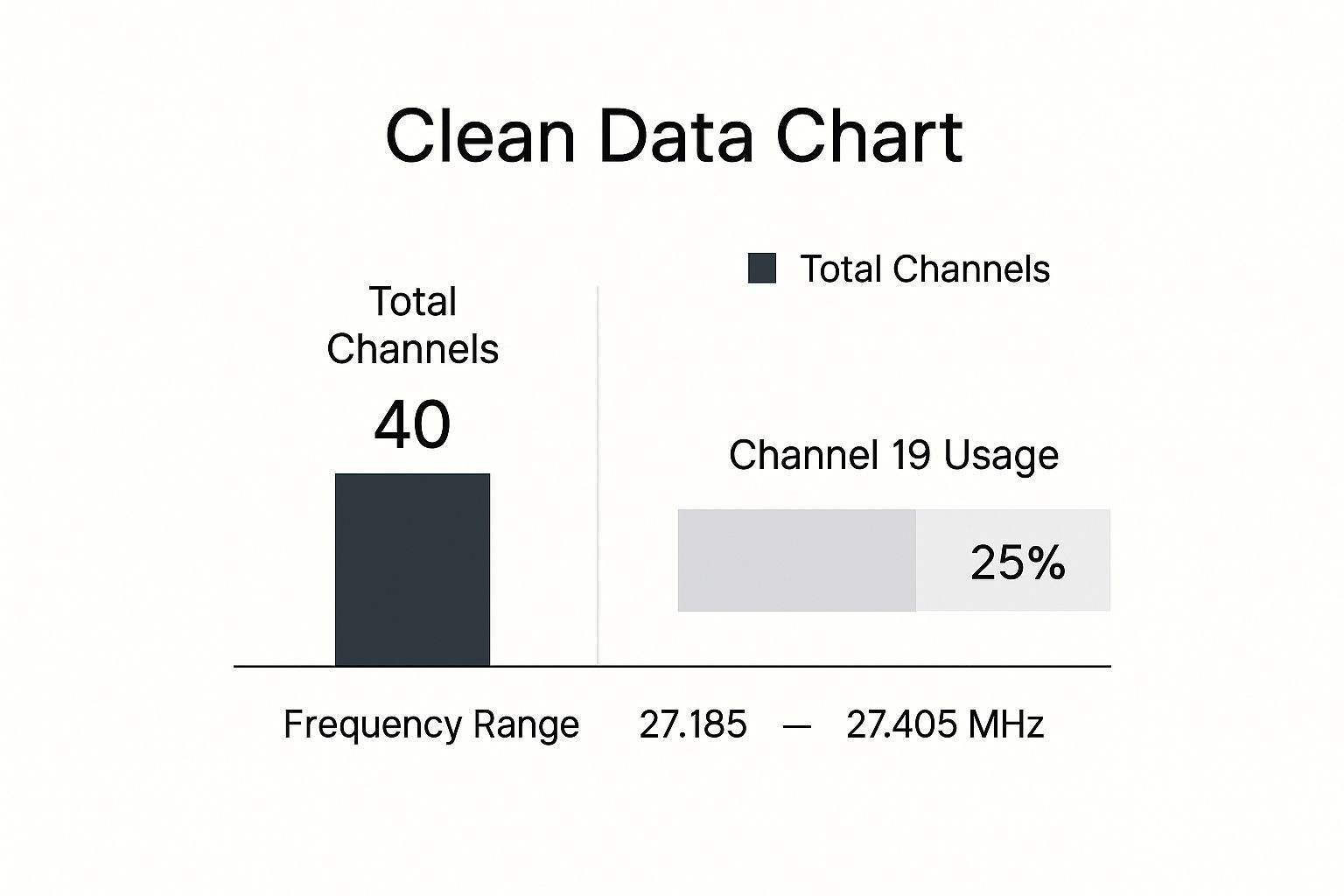
This infographic highlights key details about CB radio channels. You'll see the 40 channels within the 27.185 to 27.405 MHz range. It's important to note that New Zealand operates on the 26MHz frequency band. Notice how Channel 19 accounts for 25% of CB radio use, demonstrating its vital role in highway communication. This underscores the importance of a CB radio that operates effectively on this channel within New Zealand's frequency allocation.
Let's talk about the backbone of New Zealand's transport industry: AM CB radios. These radios are a common sight (and sound) in trucks across the country. Their popularity stems from their reliable performance in challenging conditions.
Top CB Radio Models for Kiwi Truckers
Selecting a CB radio for professional transport in New Zealand requires careful research. The 26MHz frequency requirement is paramount. The demanding conditions on New Zealand roads call for robust and dependable equipment.
- 26MHz Compatibility: This is crucial for legal operation in New Zealand. Always confirm this specification before purchasing.
- Robust Construction: Opt for a radio designed to handle vibrations, dust, and temperature changes. A metal chassis often indicates a durable build.
- Clear Audio: Look for features like noise-canceling and adjustable squelch control to minimize background noise, particularly important in noisy truck cabs.
- Channel Scanning: Efficient channel scanning is vital for quick communication, especially in heavy traffic.
- Public Address (PA) Capability: This feature allows drivers to communicate outside the vehicle, which can be useful for directing traffic or assisting at incidents.
You might find this helpful: How to choose your GME UHF CB radio.
To help you choose the right model, we've compiled a comparison of some top-rated CB radios suitable for the New Zealand transport industry. This table focuses on features important for professional drivers.
To help you choose the right model, we've compiled a comparison of some top-rated CB radios:
| Model | 26MHz Compatible | Power Output | Transport Rating | Key Professional Features |
|---|---|---|---|---|
| Model A | Yes | 4W | Excellent | Noise-canceling, PA, Channel Scanning, Durable Construction |
| Model B | Yes | 4W | Good | Channel Scanning, Durable Construction |
| Model C | Yes | 1W | Fair | Compact, Basic Features |
This table highlights the importance of considering features like power output, noise-canceling, and durability when choosing a CB radio for professional use. Remember to always confirm 26MHz compatibility for use in New Zealand.
Understanding AM, FM, and SSB
AM remains the standard for CB radio in New Zealand's transport sector. Understanding the differences between AM, FM, and Single Sideband (SSB) is useful. AM is simple and widely compatible. FM typically offers clearer audio but may have limited range. SSB provides greater range and power efficiency but is more complex and less common in general transport due to its narrower bandwidth.
Power Output Considerations
New Zealand has regulations regarding maximum CB radio power output. Exceeding these limits is illegal and can result in penalties. Within legal limits, a higher power output can extend range, which is particularly helpful in remote areas. Consider your usual operating environment.
Antenna Selection and Installation
The antenna is a crucial part of your CB radio setup. Correct installation and tuning significantly affect communication range and clarity. Various antenna types suit different vehicles and driving conditions. Whip antennas are common for trucks, while magnetic mount antennas provide flexibility for drivers who switch vehicles frequently. Professional installation is recommended for optimal performance and minimal interference.
Choosing the right CB radio and ensuring proper installation are essential for clear and reliable communication. This enhances safety and efficiency on New Zealand roads, improving coordination, minimizing downtime, and increasing situational awareness for truckers nationwide.
Choosing Your Perfect CB Radio NZ Setup
Choosing a CB radio in New Zealand requires more thought than simply picking the first one on the shelf. The 26MHz frequency used here sets us apart from the international standard of 27MHz, significantly limiting your options. A wrong choice could mean an expensive paperweight instead of a useful communication tool. This guide will help you navigate the process, whether you're new to CB radio or a seasoned user looking to upgrade.
Understanding AM, FM, and SSB
First, let’s break down the differences between Amplitude Modulation (AM), Frequency Modulation (FM), and Single Sideband (SSB). AM is the most common mode in New Zealand, particularly in the transport industry. It’s the reliable workhorse of CB radio – simple to use and widely understood. FM offers better audio clarity, which makes it a great choice for local communication where range isn’t a priority. SSB provides maximum range and power efficiency, but it requires more technical know-how and isn't as popular for everyday use. For most New Zealanders, especially in transport, AM is the go-to option.
Essential Features to Consider
Beyond transmission modes, other features impact a CB radio’s suitability. Channel capacity is simple – more channels mean more options for communication. Weather resistance is crucial given New Zealand’s diverse climate. You’ll need a radio that can handle everything from Northland’s humidity to Southland’s snow. Think about integration capabilities with modern vehicle electronics, particularly if you’re installing in a newer vehicle. This can significantly improve sound quality and usability.
Budgeting for Your CB Radio
CB radios come in a wide price range, from basic entry-level models to professional-grade units. Entry-level options are fine for casual users who need simple communication. If you depend on your CB radio, investing in a higher-end model with advanced features and greater durability is worthwhile. It's similar to choosing between jandals and hiking boots—both are footwear, but the right choice depends on your needs.
Verifying 26MHz Compatibility
Before purchasing any CB radio in New Zealand, always confirm 26MHz compatibility. Many radios sold internationally operate on 27MHz and won’t work here. Double-check the specifications, or contact the seller if you’re unsure. This simple check can save you from frustration and wasted money.
Real-World Performance vs. Specifications
Remember that the specifications sheet only tells part of the story. Factors such as antenna quality and installation have a huge impact on actual performance. Consider getting professional advice, especially for self-installation. A poorly installed antenna can cripple even the most expensive CB radio.
Avoiding Common Purchasing Mistakes
Many people make the mistake of buying solely on price. While budget matters, prioritize features and compatibility. Another common error is overlooking the antenna. A high-quality antenna is just as important as the radio itself. Investing in both ensures optimal performance and prevents disappointment.
By considering these points, you can select a CB radio setup that fits your specific needs and budget, ensuring clear communication in New Zealand’s unique CB radio environment. This knowledge helps avoid expensive mistakes and allows you to confidently join the conversation.
CB Radio NZ Installation: Getting Maximum Performance
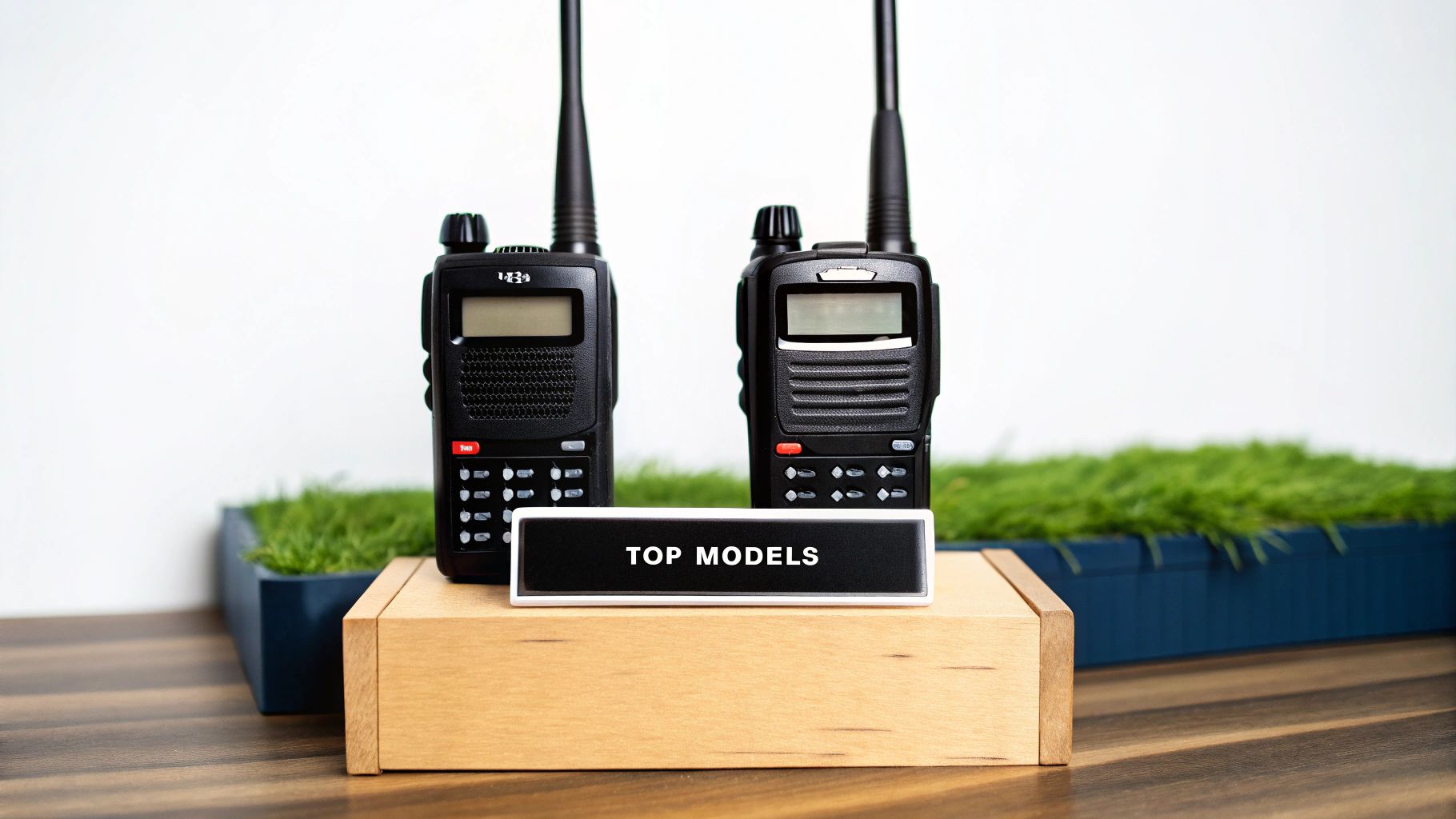
Even the best CB radio can perform poorly without proper installation. New Zealand's diverse terrain, from Auckland’s urban areas to the South Island's open roads, requires a strategic approach. Your installation directly affects whether you get clear, professional-grade communication or weak, frustrating signals. This guide helps you optimize your cb radio nz setup for the best performance.
Mounting Location: The Foundation of a Good Signal
Choosing the right mounting location for your CB radio and antenna is the first step. This largely depends on your vehicle type. For utes, a common and effective spot for the antenna is a bull bar mount. This gives a solid grounding point and elevates the antenna for optimal range.
In a car, a roof-mounted magnetic mount antenna offers flexibility. For heavy trucks, mirror mounts are often preferred. For installations in potentially hazardous environments, check out our guide on what is an intrinsically safe radio.
Antenna Selection and Positioning: Reaching Further
Your antenna is vital. A longer antenna usually transmits and receives over a greater distance. However, it's more susceptible to damage, especially in low-clearance areas.
Consider a shorter antenna if you often drive in tight spots or forested areas. Antenna positioning also matters. A vertically mounted antenna sends its signal horizontally in all directions, ideal for general use. Slight adjustments, however, can improve performance based on the specific terrain.
Grounding: Eliminating Interference
Proper grounding is key to minimizing interference. A poor ground connection can cause static and reduced range. Make sure your antenna mount has a clean, solid connection to the vehicle's chassis.
This creates a low-resistance path for stray electrical currents, stopping them from affecting your CB radio's performance. A good ground acts like a drain for unwanted electrical “noise.”
Cable Routing: Protecting Your Signal
How you route your antenna cable is important too. Avoid running the cable near other electrical wiring, as this can cause interference. Use high-quality coaxial cable made for CB radios.
Cheaper cables are more likely to lose signal strength. Also, secure the cable properly to prevent damage from vibration or rubbing against other vehicle parts. These precautions can significantly improve your CB radio's range and clarity.
Integrating with Modern Vehicle Electronics
Many modern vehicles have complex electronics that can sometimes interfere with CB radio operation. If you have problems, a noise filter installed on your vehicle's power line can help. This filter blocks unwanted electrical signals from getting into the CB radio, resulting in clearer audio.
Troubleshooting and Optimization
Even with careful planning, problems can still occur. If you experience low range or excessive static, check all connections and cabling systematically. Ensure the antenna is properly tuned to New Zealand's 26MHz frequency.
Also, try different antenna placements to find the best position for your vehicle and typical driving conditions. For professional drivers, maximizing performance is crucial. Make sure your chosen cb radio nz model is built for constant use.
Remember, New Zealand's 26MHz frequency is different from many other countries. Double-check compatibility if you are buying a radio from overseas. By focusing on these key installation aspects, you can enjoy the full potential of your CB radio across New Zealand's varied and challenging terrain.
CB Radio NZ Etiquette: Communicating Like a Pro
Using a CB radio in New Zealand isn't just about pushing a button and talking. It's about understanding and respecting the shared space of the airwaves. Like any good conversation, there are unwritten rules that help things run smoothly. This guide will cover the basics of CB radio etiquette, helping you communicate effectively and respectfully, whether you’re a seasoned trucker or a weekend warrior.
Calling Procedures and Identification: Making a Good First Impression
Before transmitting, take a moment to listen to the channel. Ensure no conversations are in progress. Once clear, announce your call sign or handle in a clear and concise manner. This lets others know you’re present and ready to communicate. And don't forget, New Zealand operates on the 26MHz frequency, so double-check your radio's compatibility.
Channel Usage Protocols: Sharing the Airwaves
CB radio channels are a shared resource, much like a community hall. Avoid lengthy transmissions that monopolize the channel. Keep your messages brief and to the point, allowing others the opportunity to communicate as well.
Emergency Procedures: When Seconds Count
In emergencies, CB radio can be a critical communication tool, especially in areas with limited cell phone coverage. If you have a genuine emergency, the proper procedure is to clearly state "Mayday" three times. Follow this with your location and the nature of the emergency. This standardized approach ensures your call is understood and prioritized.
Handling Difficult Situations: Staying Calm Under Pressure
You might occasionally encounter challenging individuals or situations on the CB radio. The best approach is to remain calm and professional. Avoid arguments and refrain from using offensive language. Maintaining a positive and respectful atmosphere benefits everyone in the CB radio community. For tips on handling various situations and ensuring your safety, check out this guide on improving building security.
New Zealand CB Radio Lingo: Speaking the Local Dialect
Like any close-knit group, CB radio operators in New Zealand have their own unique slang and terminology. Learning these common phrases, especially if you're involved in the transport industry—a sector where AM CB radios are still prevalent—can significantly enhance your communication. Understanding nuances, such as the difference between "Breaker, breaker" and a simple "Hello," shows respect and helps you integrate into the community.
The Importance of Listening: A Two-Way Street
Effective CB radio communication isn't just about talking; it's equally about listening. Paying attention to ongoing conversations helps you avoid interrupting others and allows you to gather valuable information. It’s a two-way street: listening is as crucial as transmitting.
Maintaining the Kiwi Spirit: Respect and Cooperation
Ultimately, the CB radio community in New Zealand thrives on mutual respect and cooperation. By adhering to these etiquette guidelines, you contribute to a positive and helpful environment. This enhances everyone’s CB radio experience, especially given the unique considerations of operating on 26MHz, as opposed to the 27MHz standard used in other countries. This difference makes choosing the right equipment and understanding the limitations of range and signal propagation even more critical.
The Future Of CB Radio NZ: Staying Relevant In A Digital World
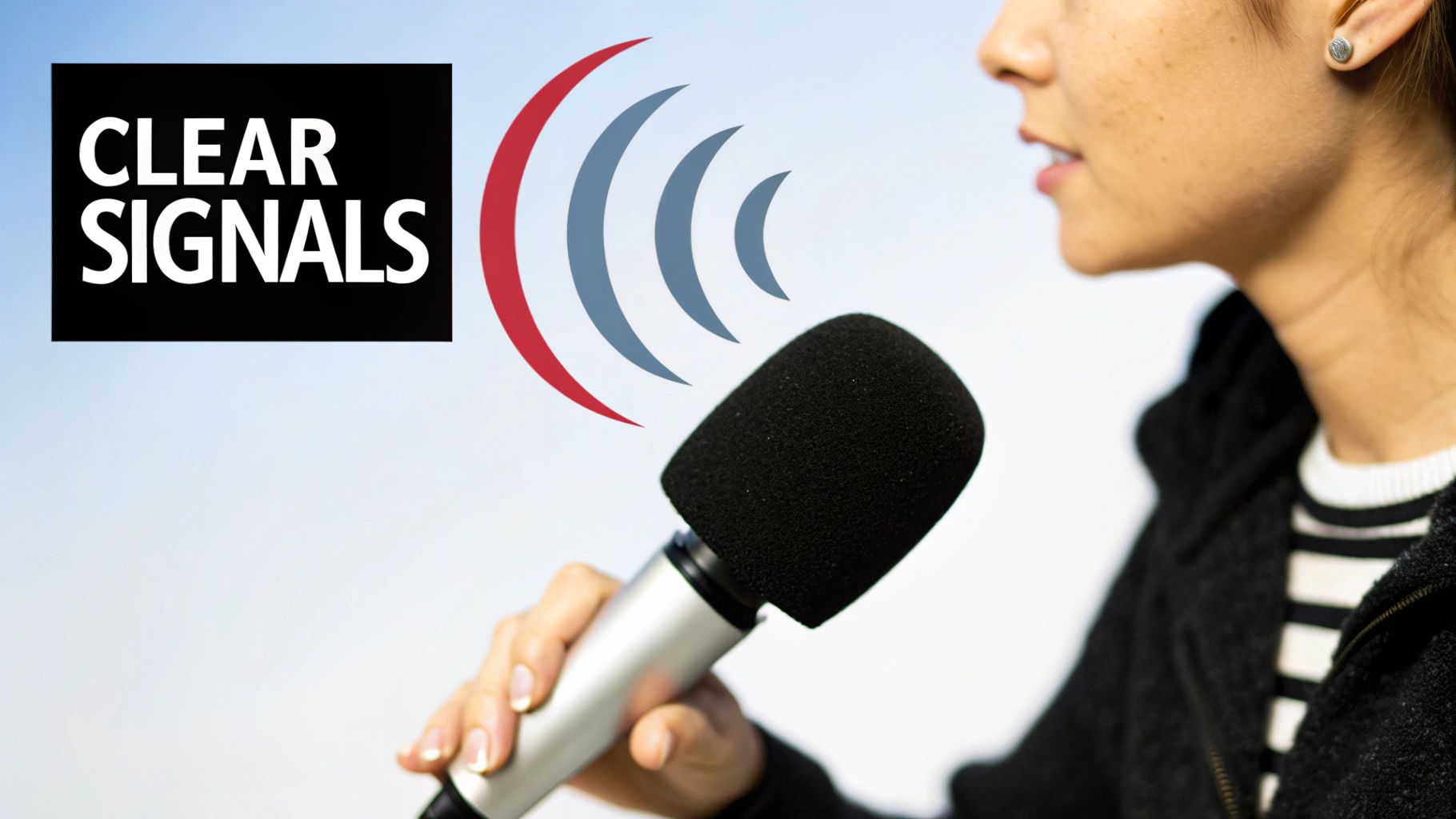
While smartphones dominate much of our communication, CB radio continues to play a significant role in New Zealand. This is especially true in industries where reliable communication is essential, regardless of cellular coverage. This article explores the ongoing importance of cb radio nz and its place in our increasingly connected world. We'll examine current uses, emerging trends, and the passionate community that keeps this unique communication method thriving.
Current Usage: Where CB Radio Remains King
CB radio remains a cornerstone of communication across several key sectors in New Zealand. Its resilience and simplicity make it an invaluable tool in situations where other forms of communication might fall short.
-
Transport: AM CB radios are deeply embedded in the trucking industry, providing a vital communication link between drivers. This is particularly important on long hauls where mobile phone reception can be unreliable.
-
Agriculture: Farmers often depend on CB radio for quick communication across their properties, particularly in remote locations beyond the reach of cell towers. This instant connection allows for efficient operations and improved safety.
-
Emergency Services: When other communication networks fail during emergencies, CB radio can be a lifeline. This has been demonstrated in recent natural disasters where CB radio provided critical communication channels.
-
Recreational Communities: From four-wheel drive enthusiasts to boating clubs, recreational users rely on CB radio to stay in touch in areas with limited or no cell service. This enhances safety and allows for coordinated activities.
The following table highlights the current usage patterns and future trends of CB radio across different sectors in New Zealand. This data illustrates the continued reliance on CB radio communication, particularly in sectors where reliable communication is paramount.
CB Radio NZ Usage Trends Across Key Sectors
| Industry Sector | Current Usage Level | Primary Applications | Projected Trend |
|---|---|---|---|
| Transport | High | Driver communication, logistics coordination | Continued high usage |
| Agriculture | Moderate | Farm operations, emergency communication | Stable growth |
| Emergency Services | Moderate | Backup communication, disaster relief | Increasing adoption |
| Recreational Communities | Moderate | Off-road communication, safety coordination | Steady growth |
As shown in the table, CB radio continues to be a significant communication tool across diverse sectors in New Zealand. The projected trend indicates sustained or even increased use in the future, highlighting its continued relevance.
Emerging Trends: Adapting to a Changing World
CB radio is not static; it continues to evolve and incorporate new technologies. This adaptability ensures its relevance in a rapidly changing communication environment.
-
Integration with Vehicle Systems: Modern CB radios are becoming increasingly integrated with vehicle electronics. This offers features like improved sound quality, noise cancellation, and more convenient control options.
-
Hybrid Communication: We're witnessing the growth of hybrid solutions that combine CB radio with other communication methods, such as satellite messaging. This provides truly comprehensive coverage, even in the most remote areas.
-
Emergency Preparedness: The reliability of CB radio during emergencies is driving renewed interest in its use for disaster preparedness. Individuals, communities, and organizations are recognizing the value of having a communication system that doesn't rely on vulnerable infrastructure.
Community and Mentorship: The Heart of CB Radio
The vibrant cb radio nz community is crucial to its continued success. This passionate community fosters knowledge sharing, support, and a sense of camaraderie among users.
-
Local CB Radio Clubs: These clubs offer a place for enthusiasts to meet, exchange information, organize group outings, and promote the hobby.
-
Online Forums: Online platforms dedicated to CB radio provide valuable resources for troubleshooting technical issues, sharing advice, and engaging in discussions.
-
Mentorship: Experienced CB radio operators often mentor newcomers, guiding them through the nuances of the 26MHz frequency and helping them become proficient users.
Realistic Expectations: The Path Forward
While CB radio isn't likely to replace mobile phones, its unique strengths ensure its continued relevance. It provides reliable, simple, and independent communication, free from the constraints of commercial networks. While general usage may shift, sectors like emergency preparedness and recreational activities will likely see continued, and possibly increased, reliance on cb radio nz.
Looking for reliable communication solutions in New Zealand? Mobile Systems Limited offers a wide range of CB radios and communication equipment. They provide expert advice, professional installation, and ongoing support to meet your specific needs.
Article created using Outrank

